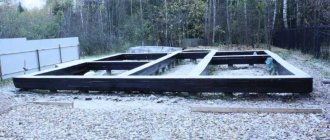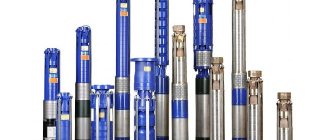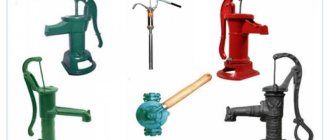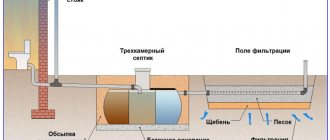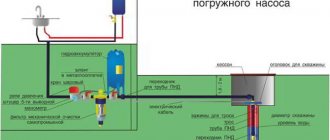A cesspool is a chamber for receiving sewage (pit). This is an underground element of a non-sewered latrine. Its contents are removed using a sewage disposal machine, and the device must comply with the requirements of sanitary standards, which establish not only the distance from the cesspool to the house, but also regulate its permissible position relative to other buildings on its own and neighboring plots.
Pumping out the contents of a cesspool using a sewage disposal machine
Permission
Before constructing a cesspool, you must obtain permission. For this purpose, the SES provides:
- Scheme of the location of the object on the site.
- The design of the structure, and it must comply with sanitary standards and regulations.
If documents are submitted that do not comply with the requirements of the law, permission will not be obtained.
But that’s not all, because after construction is completed and even several years later, an inspection inspector may come. In fact, the distance to the cesspool from the well and from other key points must correspond to the submitted documents. Inspectors do not conduct inspections at their own discretion; they often appear on a “tip” from neighbors.
Important! Do not neglect obtaining a permit; it will not cost much. You will have to stand in the corridors of the government agency, but it is cheaper than paying a fine if the distance from the well to the cesspool is incorrect.
It will be possible to obtain permission only if the cesspool is located not on the territory of a neighboring plot, but on your own. Moreover, it does not matter whether this (someone else’s) plot is residential or not and whether it is owned by someone.
Common planning mistakes and potential consequences
Failure to comply with the standards leads to pronounced consequences - the greenery on the site will wither and wither. There will be a constant unpleasant odor inside the house. If depressurization and leakage occur, a massive death of fish is observed in reservoirs.
There are several common planning mistakes:
- The wrong shape has been chosen for the cesspool. The best option is to use the principle of the structure of a standard well. Typically, the soil is strengthened using concrete rings with strong reinforcement. Contact with the ground must be avoided by all possible means, including the use of coating, water-resistant insulation.
- The distance to the bottom of the pit from the ground surface is not maintained. The maximum level is up to three meters. If you make your well deeper, regular pumping of wastewater will be very difficult.
- The pit cover is not installed correctly. It must withstand heavy loads. It will also be necessary to provide an additional thermal insulation layer.
- The design does not include ventilation. For this, a pipe with an average diameter of 100 mm is used. It is located at a height of more than 70 cm from the ground level. This is necessary in order to reduce the level of internal gas formation.
If you follow the rules regarding the distance of the cesspool from the house, you don’t have to worry about problems with operation. Correctly develop a preliminary scheme at the construction planning stage, choose a convenient technology for concreting or high-quality reinforced concrete rings, take care of insulation. This guarantees the avoidance of fines from regulatory authorities, as well as no harm to the environment.
Types of structures
The placement of a drainage pit in a private house differs in distance standards, depending on the type. The classification is based on the tightness of the structure. Types:
- A simple pit is a pit in the ground into which wastewater is discharged. There is no tightness in the design, so drains can spread in any direction. Here the distances should be maximum from all key points on the site.
- Pit with hard walls. They create less emissions into the soil, which means they are safer. The drainage does not seep through the walls; it goes only into the soil, through the filter bottom - a mixture of sand and crushed stone. Since the wastewater still leaves the cesspool, the distance from the house and from the well is also the maximum according to the standards.
- Sealed pits or plastic containers do not allow sewage to enter the soil at all. The cesspool is cleaned using the pumping method. It is allowed to maintain a minimum distance from the well.
Important! According to SanPiN, any cesspool must be installed only in accordance with the project and after approval by the relevant regulatory authorities.
How is a cesspool cleaned?
Well cleaning is usually carried out in early spring. The design of the storage tank may involve pumping out waste with a special machine, or the septic tank may be cleaned manually. The plastic storage tank is cleaned using a sewage disposal machine. The machine hose is threaded through a special hatch in a plastic structure.
Between the buildings on the site, it is necessary to leave a sufficient gap for the passage of the vehicle with which the cleaning will be carried out.
In order for the sewage system on the farm to function well, it is necessary to monitor the sewage pit and operate it correctly. An old sewer can overflow very quickly. You have to clean it frequently. Sediment can clog sewer lines. Contaminated soil prevents wastewater from seeping out.
To solve these problems, you must first completely clean the pit. Then fill it with clean water so that the solid residues dissolve or soften. Every other day, special biological products are added to the water. They contain bacteria that feed on the remains of sewage and sludge in the pit. All surfaces of the structure will be cleaned. Drainage outlets will be restored. Microorganisms will also enter the pipes leading to the pit and clean them of grease, which will prevent them from clogging during future use for a long time.
SNiP standards
According to SNiP, a cesspool is an object of increased environmental hazard, therefore its placement must comply with certain standards, namely:
- The distance between the well and the cesspool is 20-50 meters. The same standards apply to the distance from any source of drinking water - a well, a standpipe, or another type of water intake.
- From the foundation of your own house, the neighbor’s, the foundations of other buildings, at least 10-12 meters. If you place the cesspool closer, in the event of a violation of the integrity of the wastewater storage facility, there is a risk of erosion of the foundation and, as a result, destruction of the building.
- The distance from the cesspool to the water supply and its pipes. At least 10 meters; such a distance will prevent sewage from entering the water supply in the event of an accident on the sewer pipeline.
- The depth of the pit should not be more than 3 meters, and only in case of deep groundwater. If they are located high, then only sealed containers or septic tanks can be installed. In both the first and second cases, it is necessary to maintain a distance of 1 meter from the bottom of the pit to the groundwater level. The release of wastewater into the soil is dangerous because it pollutes groundwater, and therefore sources of water intake.
- There should be at least 1.5 meters to the property line (fence), but it is better to do more, then you will be able to avoid troubles with neighbors.
- To the highway, road, if there is one near the site - from 5 meters.
- Distance from a stream, river – from 10 m.
- If there are trees and shrubs on the site, then you need to place cesspools and septic tanks at a distance of 3 meters or more. The decision to move the cesspool into the garden is not the best, because the roots of the plant can simply rot from excess moisture, and besides, not all of them are so moisture-loving.
- It is also impossible to place a cesspool closer to the garden; placement standards are 20-30 meters.
Important! The arrangement of an outdoor toilet also requires compliance with similar standards if a sealed container is not used as a cesspool. A toilet in a country house, although it is not used as often as a sewer system in a private house, it must be placed in accordance with the above standards.
Well arrangement
The well is installed at the minimum distance determined by regulatory documents:
- From wastewater treatment plants.
- Residential buildings.
- Outbuildings.
- Vodoemov.
- Plot boundaries.
- Public buildings and children's institutions.
Before installing a well in the yard, it is necessary to agree with the SES on the possibility of its location in a specific location in accordance with the distance from natural resources and neighboring buildings.
Village house and well
Features of the well design include a perimeter fence to protect against small animals and birds getting into it. A lid is placed on top to protect from precipitation and dust. The best option for collecting water is to install a pump.
If there is no centralized water supply in the village, a path should be equipped for free access to drinking water for other members of the cooperative. There should be a platform made of stone or asphalt around the well, protecting it from water penetration along the rings from the outside.
If there are communications on the site
When the location of the site is such that underground communications pass through it, then a certain distance must also be maintained to them. The distance of the cesspool depends on the type of pipes:
- Asbestos-cement or reinforced concrete - from 5 meters.
- Cast iron with a diameter of up to 20 cm - 1.5 m.
- Cast iron with a diameter of more than 20 cm - from 3 m.
- Gas pipes – from 5 meters.
Important! When moving pipes away from the cesspool on a site, you should be guided by the rule, the farther the better.
Instead of results
With the advent of plastic septic tanks, the need to perform complex construction work - installation and concreting of rings - disappeared. The problem with metal corrosion, which was a common cause of breakthroughs in treatment facilities, has also been resolved. Now, if there is limestone under the soil layer, there is no need to drill it. It is enough to dig a hole of the required depth. But it is always necessary to understand in what segment a well can be drilled.
In the countryside
If you seek help from a specialist, you can reduce these standards. The rules have certain clauses that can be taken into account. For example, the distance to communications from water pipes can be reduced by using cast iron rather than plastic pipes.
Punishment for non-compliance
They are punished for violating the rules for the location of cesspools and street toilets with a ruble, that is, they issue a fine. Its size depends on several factors:
- Have any cases of violation of environmental legislation by a citizen been previously recorded?
- How badly the norms have been violated. This means that if the cesspool is closer than necessary to the foundation of the house, the fine will be less than if a potentially dangerous object is located closer than 20 meters from a source of drinking water.
The specific amount of punishment is determined by the court; it is in court that the measure of punishment for such an offense is determined. Violation of environmental standards is dangerous for many people, so fines amount to thousands of rubles.
If there is not enough space
It happens that those responsible for violating sanitary standards make excuses by saying that there is not enough space, and that is why they violated the rules. But in fact, it is possible to install a toilet correctly or arrange a cesspool. If, according to the standards, there is not enough space on the site, the solution is to construct a pit using a sealed container. There are also septic tanks and other installations that can be mounted on the surface, they are also sealed.
Of course, such solutions are more expensive than a cesspool, but by not complying with SNiP standards, the owner of the site primarily harms himself. It pollutes water and makes the soil unsuitable for growing any vegetables, trees, and shrubs.
Compliance with sanitary standards regarding the placement of a cesspool and the location of the toilet according to SNiP in the country is very important. Violation is fraught not only with fines, but also with harm to one’s own health.



